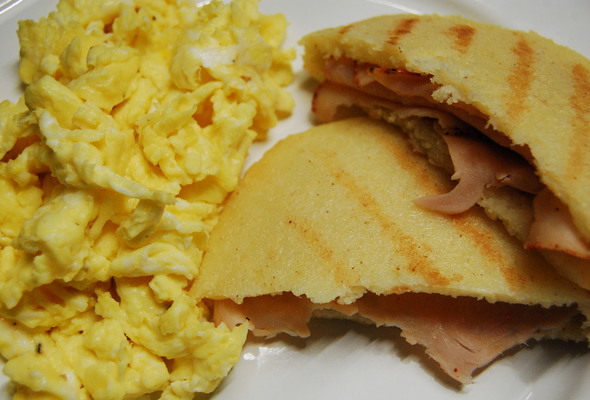My Arepa, My Home
By Alexandra Torrealba
The first bite of a Venezuelan arepa, no matter where I am, is an instant reminder of home. Since I left Caracas, my hometown, five years ago, I’ve lived in three different cities. And I’ve eaten an arepa in all of them.
The essence of arepas is simple: a round, cornmeal flatbread, usually fried, grilled or oven-baked. They can be small enough to be fried and dipped in sour cream, or large enough to be filled with shredded beef.

An arepa sliced in half, filled with deli turkey slices and served with scrambled eggs for breakfast. Photo: Alexandra Torrealba.
If you ask a person from the coast of Venezuela, they will tell you a different way of making, filling, and eating an arepa than a person from the Venezuelan highlands would. Raised in the capital city, I was taught to fill them with anything from cheese to chicken salad to avocado. Everyone eats them at least once a day, and there’s no limit as to when: an arepa is perfect for breakfast, lunch or dinner.
Breakfast arepas were my favorite. When I was eight years old, I used to wake up at the ungodly hour of 6:30 a.m. for school. I remember dragging my feet down the long hallway to my kitchen, eyes closed, still in my pajamas. The smell was blissful. My nanny would be making perfectly round and plump arepas in our very own arepa-maker: think panini-maker, but with four round, hollow crevices. “I’ll take mine in the car,” I’d say. There was comfort in knowing what I’d have for breakfast each morning. I would eat it – eyes half-open – and then get an extra 20 minutes of sleep on the way to school.
But nothing could beat my grandmother Carmen’s arepas. Breakfast at her house made my Sundays heavenly. She’d lay out the table with cream, black beans, fried plantains, shredded beef, queso fresco and avocado. A few minutes later, out she came holding a small basket with a cloth resting over the top, covering a pile of steamy, fresh arepas, grilled and then oven-baked until crisp. These were the kind of arepas I had to be fully awake to enjoy.
Arepas soon became a means of ritual. As a teenager, whenever my family and I returned from a trip abroad, arepas would be the “welcome home” meal. They were also a means of celebration: bite-sized arepas were a staple at every one of my birthday parties.
And then came college. I had moved to Washington, D.C. and was about to spend the first terrifying night of my teenage life far away from home. I looked out the window and realized I wasn’t on the same street I grew up in. But frozen and packed in my carry-on were ten homemade arepas. I unwrapped one, filled it with shredded cheese and stuck it in the microwave. While it scored a zero in texture – my grandmother would have never approved of such chewiness – the same familiar taste was there. A solid ten for making my tiny dorm room smell like home.
Moving to Paris for a yearlong study exchange didn’t stop me from bringing arepas to the other side of the world. Inside my suitcase, wrapped in winter sweaters, were my venerated packets of Harina P.A.N, the precooked white cornmeal used as the base of Venezuelan arepas. Now living in New York, I can order it online from retailers in Miami and cook arepas in my studio whenever home feels too far away.
I rarely go back to Caracas anymore. Venezuela is today a deeply polarized country, the result of almost 15 years of unrest. It’s frustrating to see how a country that saw me through the first 18 years of my life is only a shadow of what I remember. Which is why my parents, my brother and I are now here. And while there are days when I am thankful I was able to leave, there are many more days when I feel a need to return.
For now, there’s arepas. No matter how much my life shifts or how many miles I fly away from my hometown, arepas are my constant. A food that doesn’t have the pretentiousness of a gourmet meal or the ability to excite taste buds with exotic flavors, arepas evoke sweet memories of family, childhood and identity, and above all, the comfort of knowing the first bite will always taste like home.

Alexandra, where can I find good arepas in NYC?
Hi Val,
If you want Venezuelan arepas, I would recommend Caracas Arepa Bar in the East Village (East 7th Street.) The owners also have another location in Brooklyn. Enjoy!
Qué nostálgico Alexandra!! mándale un beso a tu mami